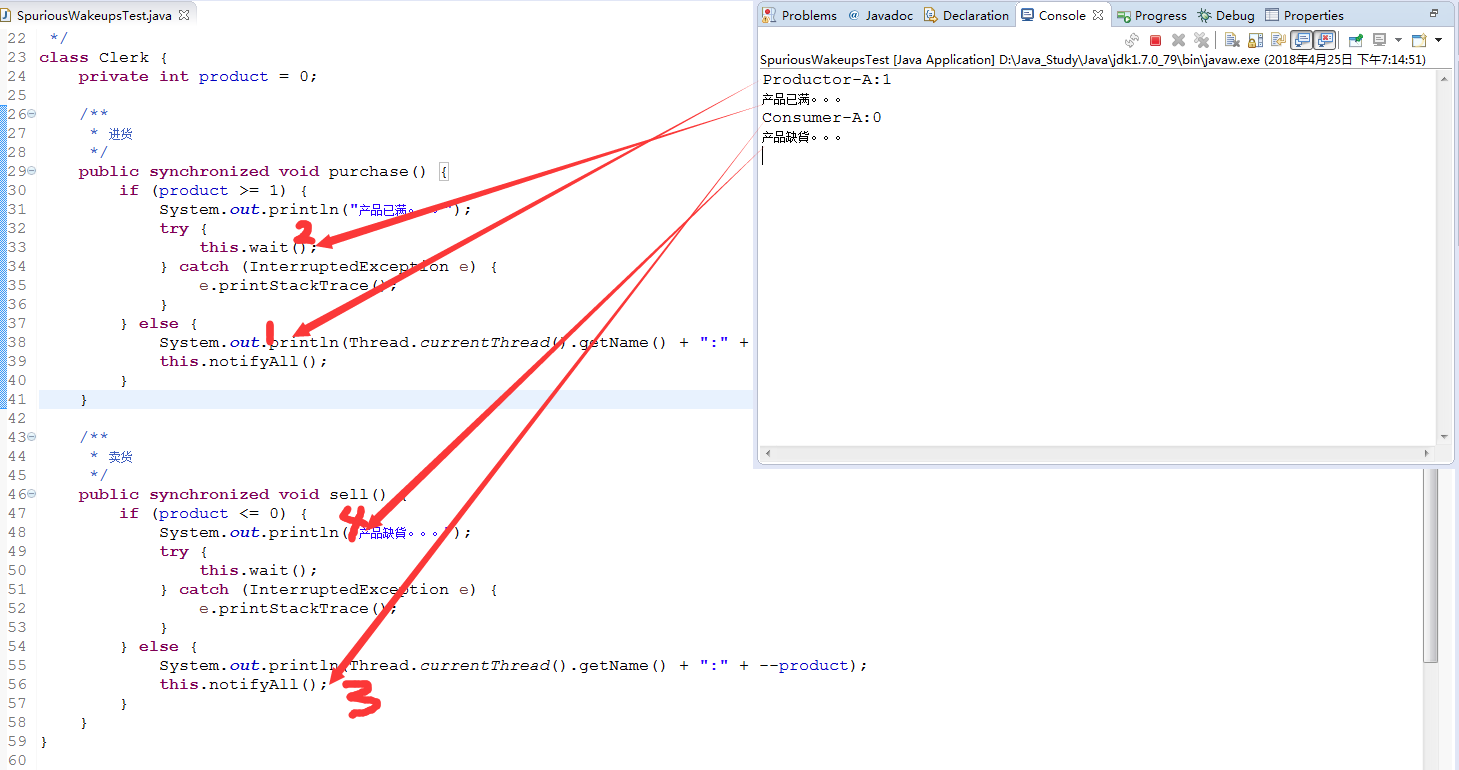Java-JUC(八):使用wait,notify|notifyAll完成生产者消费者通信,虚假唤醒(Spurious Wakeups)问题出现场景,及问题解决方案。
模拟通过线程实现消费者和订阅者模式:
首先,定义一个店员:店员包含进货、卖货方法;其次,定义一个生产者,生产者负责给店员生产产品;再者,定义一个消费者,消费者负责从店员那里消费产品。
店员:
/**
* 店员
*/
class Clerk {
private int product = 0; /**
* 进货
*/
public synchronized void purchase() {
if (product >= 10) {
System.out.println("产品已满。。。");
} else {
System.out.println(Thread.currentThread().getName() + ":" + ++product);
}
} /**
* 卖货
*/
public synchronized void sell() {
if (product <= 0) {
System.out.println("产品缺貨。。。");
} else {
System.out.println(Thread.currentThread().getName() + ":" + --product);
}
}
}
生产者
/**
* 生产者 不断的生产产品给店员
* */
class Productor implements Runnable{
private Clerk clerk;
public Productor(Clerk clerk){
this.clerk=clerk;
} public void run() {
for(int i=0;i<20;i++){
clerk.purchase();
}
}
}
消费者
/**
* 消费者 不断的从店员那里消费产品
* */
class Consumer implements Runnable{
private Clerk clerk;
public Consumer(Clerk clerk){
this.clerk=clerk;
} public void run() {
for(int i=0;i<20;i++){
clerk.sell();
}
}
}
此时,运行程序,运行结果如下:
Productor-A:1
Productor-A:2
Productor-A:3
Productor-A:4
Productor-A:5
Productor-A:6
Productor-A:7
Productor-A:8
Productor-A:9
Productor-A:10
产品已满。。。
产品已满。。。
产品已满。。。
产品已满。。。
产品已满。。。
产品已满。。。
产品已满。。。
产品已满。。。
产品已满。。。
产品已满。。。
Consumer-A:9
Consumer-A:8
Consumer-A:7
Consumer-A:6
Consumer-A:5
Consumer-A:4
Consumer-A:3
Consumer-A:2
Consumer-A:1
Consumer-A:0
产品缺貨。。。
产品缺貨。。。
产品缺貨。。。
产品缺貨。。。
产品缺貨。。。
产品缺貨。。。
产品缺貨。。。
产品缺貨。。。
产品缺貨。。。
产品缺貨。。。
从运行打印结果可以发现这里存在两个问题:
1)一旦生产者发现店员产品已满时,仍然没有停止生产产品,在不断地生产生产产品;
2)一旦消费者发现店员产品缺货时,依然时不断地消费消费。
这里明显是有缺陷的,现实中应该是:一旦发现货物满时,就不在进货,而是开启卖货行为;当卖货行为发现无货时,开始进货行为。
针对生产者消费者改进:
消费者、生产者、客户端调用代码不变,只修改店员类:
/**
* 店员
*/
class Clerk {
private int product = 0; /**
* 进货
*/
public synchronized void purchase() {
if (product >= 10) {
System.out.println("产品已满。。。");
try {
this.wait();
} catch (InterruptedException e) {
e.printStackTrace();
}
} else {
System.out.println(Thread.currentThread().getName() + ":" + ++product);
this.notifyAll();
}
} /**
* 卖货
*/
public synchronized void sell() {
if (product <= 0) {
System.out.println("产品缺貨。。。");
try {
this.wait();
} catch (InterruptedException e) {
e.printStackTrace();
}
} else {
System.out.println(Thread.currentThread().getName() + ":" + --product);
this.notifyAll();
}
}
}
此时运行结果:
Productor-A:1
Consumer-A:0
产品缺貨。。。
Productor-A:1
Productor-A:2
Productor-A:3
Productor-A:4
Productor-A:5
Productor-A:6
Productor-A:7
Productor-A:8
Productor-A:9
Productor-A:10
产品已满。。。
Consumer-A:9
Consumer-A:8
Consumer-A:7
Consumer-A:6
Consumer-A:5
Consumer-A:4
Consumer-A:3
Consumer-A:2
Consumer-A:1
Consumer-A:0
产品缺貨。。。
Productor-A:1
Productor-A:2
Productor-A:3
Productor-A:4
Productor-A:5
Productor-A:6
Productor-A:7
Productor-A:8
Consumer-A:7
Consumer-A:6
Consumer-A:5
Consumer-A:4
Consumer-A:3
Consumer-A:2
Consumer-A:1
此时,从结果运行来说是按照我们希望的结果出现了。
改进后带来问题一:
修改店员类的最大进货数为1,把生产者一次生产20修改为2,消费者一次消费20也修改为2。
/**
* 生产者 不断的生产产品给店员
*/
class Productor implements Runnable {
private Clerk clerk; public Productor(Clerk clerk) {
this.clerk = clerk;
} public void run() {
for (int i = 0; i < 2; i++) {
clerk.purchase();
}
}
} /**
* 消费者 不断的从店员那里消费产品
*/
class Consumer implements Runnable {
private Clerk clerk; public Consumer(Clerk clerk) {
this.clerk = clerk;
} public void run() {
for (int i = 0; i < 2; i++) {
clerk.sell();
}
}
}
店员类:
/**
* 店员
*/
class Clerk {
private int product = 0; /**
* 进货
*/
public synchronized void purchase() {
if (product >= 1) {
System.out.println("产品已满。。。");
try {
this.wait();
} catch (InterruptedException e) {
e.printStackTrace();
}
} else {
System.out.println(Thread.currentThread().getName() + ":" + ++product);
this.notifyAll();
}
} /**
* 卖货
*/
public synchronized void sell() {
if (product <= 0) {
System.out.println("产品缺貨。。。");
try {
this.wait();
} catch (InterruptedException e) {
e.printStackTrace();
}
} else {
System.out.println(Thread.currentThread().getName() + ":" + --product);
this.notifyAll();
}
}
}
此时运行结果:

从运行结果上来看,程序是一个死锁现象。
为什么会发生死锁问题?
从运行结果上来看分析:

分析:
1)当purchase()运行“2”是处于this.wait()等待状态时,此时sell()开始运行;
2)sell()运行时,第一次走3当运行到this.notifyAll()时,开始运行4和purchase()等待向下执行(一旦向下执行purchase将不再被调用,原因生产者只有两次循环机会),而运行‘4’时打印‘产品缺货’,而且代码走入this.wait()处于一直等待状态。
因此会看到程序一直未结束状态,这个属于代码的一个BUG。
解决方法:
修改店员类:
/**
* 店员
*/
class Clerk {
private int product = 0; /**
* 进货
*/
public synchronized void purchase() {
if (product >= 1) {
System.out.println("产品已满。。。");
try {
this.wait();
} catch (InterruptedException e) {
e.printStackTrace();
}
} System.out.println(Thread.currentThread().getName() + ":" + ++product);
this.notifyAll();
} /**
* 卖货
*/
public synchronized void sell() {
if (product <= 0) {
System.out.println("产品缺貨。。。");
try {
this.wait();
} catch (InterruptedException e) {
e.printStackTrace();
}
} System.out.println(Thread.currentThread().getName() + ":" + --product);
this.notifyAll();
}
}
在运行发现程序正常结束,打印结果如下:
Productor-A:1
产品已满。。。
Consumer-A:0
产品缺貨。。。
Productor-A:1
Consumer-A:0
改进后带来问题二(虚假唤醒):
此时修改客户端调用代码:
public class SpuriousWakeupsTest {
public static void main(String[] args) {
Clerk clerk = new Clerk();
Productor productor = new Productor(clerk);
Consumer consumer = new Consumer(clerk);
new Thread(productor, "Productor-A").start();
new Thread(consumer, "Consumer-A").start();
new Thread(productor, "Productor-B").start();
new Thread(consumer, "Consumer-B").start();
}
}
之前只有一个生产者和一个消费者,修改后让其拥有两个生产者和两个消费者,此时运行代码如下:
Consumer-A:-1
产品缺貨。。。
Productor-A:0
Productor-A:1
Consumer-A:0
Consumer-B:-1
产品缺貨。。。
Productor-B:0
Productor-B:1
Consumer-B:0
从代码分析逻辑来看,输出解雇貌似毫无逻辑,此现象就是一个虚假唤醒现象。
问题分析:
1)缺货时,两个consumer线程都进入wait状态;
2)当另外一个生产者生产了产品并调用了notifyall,此时两个consumer线程都被唤醒并跳过wait,进入消费代码
System.out.println(Thread.currentThread().getName() + ":" + --product);
,因此导致一个输出产品数为0,另外一个产品数为-1。
解决办法:
基于while来反复判断进入正常操作的临界条件是否满足:
synchronized (obj) {
while (<condition does not hold>)
obj.wait();
... // Perform action appropriate to condition
}
此处理方案来此ava.lang.Object API的wati方法说明信息中。
店员修改:
/**
* 店员
*/
class Clerk {
private int product = 0; /**
* 进货
*/
public synchronized void purchase() {
while (product >= 1) {
System.out.println("产品已满。。。");
try {
this.wait();
} catch (InterruptedException e) {
e.printStackTrace();
}
} System.out.println(Thread.currentThread().getName() + ":" + ++product);
this.notifyAll();
} /**
* 卖货
*/
public synchronized void sell() {
while (product <= 0) {
System.out.println("产品缺貨。。。");
try {
this.wait();
} catch (InterruptedException e) {
e.printStackTrace();
}
} System.out.println(Thread.currentThread().getName() + ":" + --product);
this.notifyAll();
}
}
运行结果:
Productor-A:1
产品已满。。。
Consumer-B:0
产品缺貨。。。
Productor-B:1
产品已满。。。
Consumer-A:0
产品缺貨。。。
Productor-B:1
Consumer-B:0
Productor-A:1
Consumer-A:0
Java-JUC(八):使用wait,notify|notifyAll完成生产者消费者通信,虚假唤醒(Spurious Wakeups)问题出现场景,及问题解决方案。的更多相关文章
- java多线程 生产者消费者案例-虚假唤醒
package com.java.juc; public class TestProductAndConsumer { public static void main(String[] args) { ...
- java 多线程之wait(),notify,notifyAll(),yield()
wait(),notify(),notifyAll()不属于Thread类,而是属于Object基础类,也就是说每个对像都有wait(),notify(),notifyAll()的功能.因为都个对像都 ...
- Java多线程之wait(),notify(),notifyAll()
在多线程的情况下,因为同一进程的多个线程共享同一片存储空间,在带来方便的同一时候,也带来了訪问冲突这个严重的问题.Java语言提供了专门机制以解决这样的冲突,有效避免了同一个数据对象被多个线程同一时候 ...
- 如何在 Java 中正确使用 wait, notify 和 notifyAll – 以生产者消费者模型为例
wait, notify 和 notifyAll,这些在多线程中被经常用到的保留关键字,在实际开发的时候很多时候却并没有被大家重视.本文对这些关键字的使用进行了描述. 在 Java 中可以用 wait ...
- 转:【Java并发编程】之十:使用wait/notify/notifyAll实现线程间通信的几点重要说明
转载请注明出处:http://blog.csdn.net/ns_code/article/details/17225469 在Java中,可以通过配合调用Object对象的wait()方法和no ...
- 【java线程系列】java线程系列之线程间的交互wait()/notify()/notifyAll()及生产者与消费者模型
关于线程,博主写过java线程详解基本上把java线程的基础知识都讲解到位了,但是那还远远不够,多线程的存在就是为了让多个线程去协作来完成某一具体任务,比如生产者与消费者模型,因此了解线程间的协作是非 ...
- 【Java并发编程】:使用wait/notify/notifyAll实现线程间通信
在java中,可以通过配合调用Object对象的wait()方法和notify()方法或notifyAll()方法来实现线程间的通信.在线程中调用wait()方法,将阻塞等待其他线程的通知(其他线程调 ...
- 【Java并发编程】之十:使用wait/notify/notifyAll实现线程间通信的几点重要说明
在Java中,可以通过配合调用Object对象的wait()方法和notify()方法或notifyAll()方法来实现线程间的通信.在线程中调用wait()方法,将阻塞等待其他线程的通知(其他线程调 ...
- java并发编程(十)使用wait/notify/notifyAll实现线程间通信
转载请注明出处:http://blog.csdn.net/ns_code/article/details/17225469 wait()方法:public final void wait() thr ...
随机推荐
- Mac的brew和brew cask区别以及安装brew cask
brew多用于命令行. brew cask主要用于有GUI的软件,例如VLC等等. brew cask是brew的一个子集,也就是一个扩展. 安装brew cask扩展: ruby -e " ...
- px 与 dp, sp换算公式?(转)
PPI = Pixels per inch,每英寸上的像素数,即 "像素密度" xhdpi: 2.0 hdpi: 1.5 mdpi: 1.0 (baseline) ldpi: 0. ...
- flashsim配置2015最新版本
http://blog.csdn.net/Eidosper/article/details/46458469 http://www.doc88.com/p-7314277317013.html htt ...
- 少女花海自拍撞亡:自拍PK火车速度,没有赢家
心理学研究,自拍是一种自我强化的过程.人们都或多或少有着自我关注的倾向,即“自恋”.而人作为有思想的群体性社会动物,有着分享和交流的欲望.尤其是现代快节奏的生活常使人感觉“亚历山大”,自拍恰恰就成为释 ...
- Windows Phone本地数据库(SQLCE):8、DataContext(翻译)
这是“windows phone mango本地数据库(sqlce)”系列短片文章的第八篇. 为了让你开始在Windows Phone Mango中使用数据库,这一系列短片文章将覆盖所有你需要知道的知 ...
- eclipse中设置自定义文档签名(工具)
今天第一次认真学习eclipse的使用,看到自定义文档签名,步骤如下: 1.点击window->preferences->java->Code Style->Code Tem ...
- C#编程(四十九)----------队列
队列 1.Queue定义 System.Collections.Queue类表示对象的先进先出集合,存储在Queue(队列)中的对象在一端插入,从另一端移除. 2.优点 (1).能对集合进行顺序处理( ...
- Android中Service类onStartCommand的返回值问题
Android开发的过程中,每次调用startService(Intent)的时候,都会调用该Service对象的onStartCommand(Intent,int,int)方法,然后在onStart ...
- cvCreateStumpClassifier
CV_BOOST_IMPL CvClassifier* cvCreateStumpClassifier( CvMat* trainData, //训练样本的数据,包含图像大小.数量,类别,权重等 in ...
- 《数据挖掘:R语言实战》
<数据挖掘:R语言实战> 基本信息 作者: 黄文 王正林 丛书名: 大数据时代的R语言 出版社:电子工业出版社 ISBN:9787121231223 上架时间:2014-6-6 出版 ...
